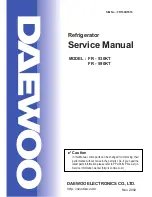
Electrical Maintenance (Rev. 04/03)
47
NOTE: If the battery was discharged enough that a boost
was needed, the alternator may not recharge the battery
because there may not be adequate current to excite the
alternator field.
UNIT WIRING
Inspect the unit wiring and the wire harnesses during sched-
uled maintenance inspections for loose, chafed or broken
wires to protect against unit malfunctions due to open or
short circuits.
ELECTRICAL CONTACTS
Inspect all relay contacts for pitting or corrosion every
1,000 operating hours, and repair or replace as necessary.
CHARGING SYSTEM (12 VDC)
Immediately after start-up, the voltmeter may show a dis-
charge condition on systems with brush type alternators.
This is due to a light film build-up on the alternator slip
rings. The film build-up occurs primarily on units that have
been sitting unused for long periods of time. The film
should disappear after a minute or two, and the voltmeter
should show a high charge rate that will continue until the
battery voltage is brought back up to normal. Under normal
running conditions, the voltmeter will show a slight charge
condition. If the voltmeter indicates a low voltage after
start-up, check the alternator belt tension and all charging
circuit connections including the battery.
NOTE: On installations where the KD-II unit is connected
to the truck battery and both units are running—it is nor-
mal for the unit charge to indicate a higher voltage while
the truck engine is running because of the truck’s higher
voltage charge rate.
PREHEAT BUZZER
The preheat buzzer module on the circuit board is designed
to indicate preheat is in operation.
RPM SENSOR
The rpm sensor is in the engine bell housing adjacent to, but
not touching, the flywheel (backed off 1/2 turn).
The rpm sensor is a device containing an inductance coil
and magnet. When the magnetic field is distorted by the
passing ring gear teeth, the inductance coil generates an ac
electrical signal that has a voltage and frequency variation
proportional to the engine rpm.
By monitoring the frequency of this signal with the µP-T,
the timing of the starter disengagement can be precisely
controlled.
If the rpm sensor fails, the starter may not disengage or
engage properly and a fault code will be generated to the
microprocessor.
Testing the RPM Sensor
Equipment required:
•
AC voltmeter capable of reading up to 10 volts
•
Ohmmeter
Summary of Contents for KD-II SR
Page 4: ......
Page 8: ......
Page 13: ...Safety Precautions Rev 04 03 v AEA40...
Page 14: ...Safety Precautions Rev 04 03 vi AEA38...
Page 33: ...Unit Description Rev 04 03 19 1 Evaporator 2 Access Door Rear View Curbside KD II SR 1 2 AEA38...
Page 37: ...Unit Description Rev 04 03 23 Power Receptacle Box KD II SR 50 AEA42...
Page 58: ...Remote Control Panel Features Rev 04 03 44...
Page 112: ...Refrigeration Maintenance Rev 04 03 98...
Page 120: ...106...
Page 146: ...132...
Page 156: ...142...
Page 162: ...148...
Page 170: ...156...
Page 172: ...158...
Page 173: ...159 KD II 30 Schematic Diagram Page 1 of 2...
Page 174: ...160 KD II 30 Schematic Diagram Page 2 of 2...
Page 175: ...161 KD II 30 Wiring Diagram Page 1 of 2...
Page 176: ...162 KD II 30 Wiring Diagram Page 2 of 2...
Page 177: ...163 KD II 50 Schematic Diagram Page 1 of 2...
Page 178: ...164 KD II 50 Schematic Diagram Page 2 of 2...
Page 179: ...165 KD II 50 Wiring Diagram Page 1 of 2...
Page 180: ...166 KD II 50 Wiring Diagram Page 2 of 2...
Page 181: ...167 KD II 50 SR 230 1 60 Wiring Diagram Page 1 of 2...
Page 182: ...168 KD II 50 SR 230 1 60 Wiring Diagram Page 2 of 2...
















































